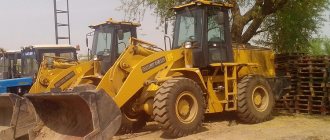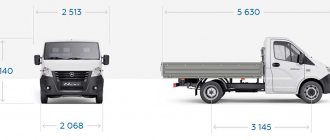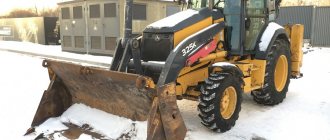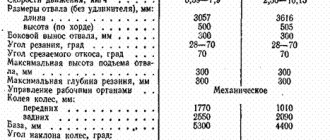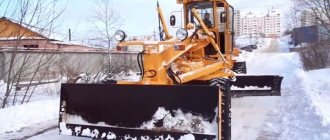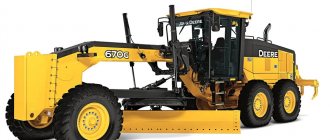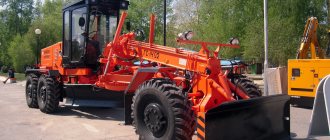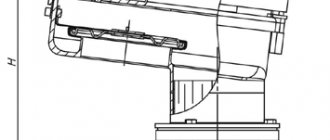A grader is a type of equipment used to level various areas or move snow and soil in winter.
Important
Graders are also used to transport construction materials by using a blade that can be raised, lowered and rotated.
It is attached to the frame of the machine and equipped with a mechanical or hydraulic control, which is driven by a motor.
There are two types of graders: conventional ones, used as a trailer, and motor graders, which move independently. As an additional device, graders are equipped with a pickaxe, consisting of large teeth that destroy road surfaces during repairs.
Graders: what they are and what they are used for
The article was prepared by specialists in the sale of spare parts for special equipment - “Sphere”.
A grader is a self-propelled or trailed machine that is used in agriculture and forestry.
The main working part of the grader is a blade with a blade, which is mounted on the machine frame. The blade can rise, fall, and rotate in different planes (vertical and horizontal). These characteristics expand the capabilities of graders.
This is interesting: Detoxification: mechanisms and methods
Rubble road
Grading of roads is indispensable when building from crushed stone. Its key feature is installation directly on the soil. The thickness of the coating is about 16 cm, and the width does not exceed 10 m.
For greater strength, the road can consist of two layers of crushed stone. And this is where graders come to the rescue, whose work begins after the completion of filling the area. Only after the motor graders have passed, and more than once, is the top layer applied.
A crushed stone road lasts a long time only with regular preventive maintenance. Correction of unevenness is carried out using a grader. The work is carried out on a coating that has previously been spilled with copious amounts of water.
Purpose of the equipment
Technical characteristics provided the technology with a wide range of applications. The variety of types allows you to choose the best option for each individual type of work.
Tasks for which a grader is used:
- Moving and leveling soil;
- Cleaning the area from snow and autumn leaves;
- Profiling and planning of slopes and areas;
- Clearing the construction site of debris;
- Cleaning of irrigation networks;
- Cleaning cuvettes.
Differences between a grader and other special equipment
Sometimes many people mistakenly believe that a grader is a special machine that is similar to a scraper or bulldozer. For example, in English, road scraper and grader are considered synonyms. Although this is extremely false. Using a scraper, you cannot profile areas and slopes on roads, as well as perform a number of other operations. They are used only for cutting small layers of soil.
The same applies to such special equipment as a bulldozer. With its help, you can only clear a road or construction site from excess soil and debris, as well as dig a pit.
Types and technical features
Grader classification:
- Light (up to 75 hp);
- Medium weight (100 hp);
- Heavy (160-180 hp);
- Extra heavy (more than 400 hp).
Light weight models are suitable for maintaining the soil surface in good condition. In winter, equipment is used to clear the area of snow.
Important! Heavy equipment should not be used to clear the area of snow. The road surface may be damaged. The weight of the machine should not exceed 9 tons.
The use of medium graders is for carrying out road repair work of medium complexity and constructing dirt roads. The weight of such machines is from 9 to 12 tons.
A heavy grader is used in cases where it is necessary to level high-density soil. This machine is capable of handling soil of varying densities.
There are semi-trailer graders. Their peculiarity is the absence of a front axle. The frame is hung on the tractor's ball pin.
Mini graders appeared in connection with modern requirements of builders. Main purpose: leveling small areas. For work on sports fields and park paths (for leveling) this is an excellent choice.
A separate subcategory consists of motor graders. Their peculiarity is that the blade has hydraulic or mechanical control. Motor graders are often equipped with an additional working tool – a picker. Purpose: destruction of the road surface, which is possible due to the presence of special teeth on the picker, the number of which varies from 7 to 11. Scope of application: agriculture, road/airfield construction.
You may also be interested in satya: “Problems of repairing special equipment.”
Classification by mode of operation:
- Mechanical;
- Hydraulic.
The advantage of hydraulic graders is that they make the job smoother and increase efficiency. A manually driven machine consists of a system of mechanisms that make it quite difficult to operate.
1920s
Bitvargen
In order to purchase equipment in the mid-20s of the twentieth century, graders produced in different countries were studied. The Bitvargen grader, produced by the Swedish company A/B Vagmaskiner, best suited our conditions. The first graders arrived in Estonia on June 26, 1926, and on June 30, the Road Ministry handed over one to the Tartu County Government and the other to the Harju County Government, says Rain Rikas, chief curator of the Road Museum (Estonia). — According to road builders, Bitvargen graders showed their best performance. The great advantage of graders was that with their help it was possible to quickly and cheaply widen narrow roads and give them the required profile. The profile lasted quite a long time, and the road surface was dry. These graders could not be used on class 3 roads (roads in poor condition with lots of rocks). It was also impossible to plan crushed stone roads, since the grader design did not correspond to this. The next ten Bitvargen graders were manufactured by A/B Vagmaskiner at the beginning of July 1927, already in Tallinn. These were the first graders produced in Estonia. In subsequent years, Ilmarine independently produced improved models of such graders. From 1926 to 1932, only 115 Bitvargen graders were manufactured.
Grader (motor grader), types, types, classes, its working equipment, application and characteristics.
Grader is a trailed or self-propelled wheeled machine with an adjustable blade located between the front and rear wheels that cuts, moves and distributes material, usually for grading purposes.
Grader (motor grader)
Working and auxiliary equipment of the grader (motor grader)
Types, types and classes of graders (motor graders)
Grader (motor grader) parameters
Application of a grader (motor grader)
Other road construction equipment: asphalt paver, bulldozer, grader, scraper
Road maintenance in winter
The most effective means of maintaining roads in winter is a motor grader. To clear roads from snow in areas with a thin snow cover and relatively weak terrain that are not subject to snow drifts, a standard grader blade is used. The blade is rotated in plan so as to ensure the removal of snow from the road surface to the side of the road at the maximum possible speed according to the conditions of wheel adhesion to the road. Additionally, to increase efficiency when working in winter conditions, motor graders from almost all major manufacturers can be equipped with various attachments at the request of customers.
As a guide for choosing working equipment appropriate for specific work on maintaining roads and airfields in winter, manufacturers recommend using the following technical equipment:
When working in winter, there is limited traction between the wheels and the road, which requires the use of snow chains. Snow chains are used on the rear drive wheels, but can also be used on the front wheels of all-wheel drive vehicles. There are several types of chains that differ from each other and are designed for use in specific applications. When using chains, the motor grader must move at a speed not exceeding 10-12 km/h. Snow chains quickly dig into the snow when removing it and can cause damage to the top layer when slipping.
Photo source: khl.com When working in winter, there is limited traction between the wheels and the road, which requires the use of snow chains
For summer road maintenance, vehicles can be equipped with sweeping brushes. For maintenance of unpaved roads, a rear raking blade is used in combination with a front dozer blade. A motor grader can be equipped with various attachments (front loader, compaction plate, rear-mounted excavator, sprinklers, etc.), which may be of purely technical interest, but from a practical and economic point of view it can be very controversial and often not justified.
The economic feasibility and sufficiency of the main and additional equipment of motor graders today is clearly defined and includes approximately the same set for all manufacturers. The range of work can only be limited by the qualifications and experience of the operator.
Tarasov V.S., Ph.D., Associate Professor MGSU, Troitsky S.N., Ph.D., Associate Professor MGSU
Our group on Telegram
Quick contact with the editors on WhatsApp!
Source
Grader (motor grader):
A grader (English grader, from the English grade - level, level) is a trailed or self-propelled machine equipped with a working element - an adjustable blade with a knife, designed for planning and profiling areas and slopes, layer-by-layer leveling of soil and other bases, moving soil, snow or loose building materials.
A grader is a special road construction equipment (machine) capable of performing various excavation, construction, road construction and transport work operations.
A grader is a mining and transporting machine equipped with a blade working element - a blade, which is located within the wheelbase.
Depending on the type of chassis, a conventional grader and a motor grader .
A motor grader is a self-propelled wheeled machine with an adjustable blade located between the front and rear wheels that cuts, moves and distributes material, usually for grading purposes.
A conventional grader is a trailed or semi-trailer machine, fixed to a base transport vehicle - a tractor or other equipment.
The grader operates at low speed – up to 3–4.5 km/h.
This is interesting: Terrace and natural terracing
Area of use
The grader is a universal machine capable of performing a wide range of tasks in the field of construction, road construction, earthworks and agriculture. The equipment is actively used for the construction of roads or airport runways. Its use allows you to plan and carry out profiling of different areas, level the soil and different foundations.
In general, many companies prefer to buy a grader to solve the following problems:
Bulldozers are better at dealing with thick layers, and graders are more recommended for leveling the top of the soil.
The choice of model is carried out taking into account the types of planned work. For example, to work on clay soils, it is better to use vehicles with maximum productivity, while on sandy soils, light machines are sufficient.
Working and auxiliary equipment of the grader (motor grader):
The main components of the grader are the basic wheeled transport vehicle and the main working equipment - a blade , as well as auxiliary (additional) working equipment - a pick, ripper, snow plow, front blade, bulldozer blade, swept blade, slopes, extensions, etc.
The blade is the main working part of the grader, which distinguishes it from other types of road construction equipment. The blade is a rectangular sheet with some radius bend. The blade can be positioned at different angles in the horizontal and vertical planes relative to the longitudinal axis of the base transport vehicle, and can also be carried out and pulled to the side. It can rise, fall and rotate in horizontal and vertical planes.
Blades of all types of graders are equipped with mechanisms with a hydraulic or mechanical drive for raising and lowering the blade, turning in two planes, distortions in the transverse plane, and tilting back and forth along the way. The blade is attached to the traction machine with a rotating mechanism and a traction frame.
Knives are attached along the bottom and side edges of the blade, respectively called the bottom knife and side knife.
Picker - auxiliary equipment in the form of a frame with removable teeth (7-11 teeth) for loosening the soil, destroying road pavements and coatings during road repairs. The pickaxe can be installed in front of the front wheels of the motor grader or between the front and rear wheels.
Ripper is an additional equipment consisting of a frame connected by means of mounting brackets to the rear of the base machine, and equipped with one or more teeth. Ripping equipment is installed not only on motor graders, but in many cases also on bulldozers and tractors.
Snow plow - a structure located in front of the front wheels and designed to move snow in the transverse direction due to the plowing action of the blade. The plow can be single-bladed or double-bladed.
Front Blade - A blade, usually with a curved surface, located in front of the front wheels and designed to rake and push material, usually in a forward direction.
Motor graders are also equipped with automatic leveling systems in order to speed up work operations and obtain surfaces with strictly defined parameters.
Motor graders can be equipped with a remote control system.
1970s
Motor grader DZ-98 . This model, which came off the assembly line of the Chelyabinsk plant in 1972, is a direct descendant of the D-395B. Among the main differences, we highlight a more powerful engine - 250 hp, an improved 6-speed gearbox. For a long time it remained the only domestic heavy-duty all-wheel drive motor grader. Various modifications are still produced today.
Motor grader DZ-99 . The D-710 model became the parent of the popular DZ-99 with a manual transmission and a 90-horsepower A-41 engine, which is still used by some enterprises today. The first grader was produced in 1972 at the Bryansk plant. Now it has many modifications, including the DZ-99-2-4, which is equipped with a 60-horsepower D-60K-S engine.
1980s
Motor grader DZ-140 . In essence, it is a slightly modified DZ-122A, but with a larger picker in the rear and only a hydromechanical gearbox. The engine used is a 136-horsepower A-01M or its 130-horsepower modification with electric start.
Motor grader DZ-143 . One of the models that actively worked on construction sites not only in the last years of the USSR, but also in the 90s of the 20th century. 12.5 tons level the ground with ease under the control of a 130 hp engine. This technique could work even in 40 degrees below zero. Currently, DZ-143 has been discontinued.
We thank the chief curator of the Estonian Road Museum, Ryan Rikas, and the TechStory.ru project for providing the photographs.
If you find an error, please select a piece of text and press Ctrl+Enter.
Types, types and classes of graders (motor graders):
Graders are classified according to running equipment, productivity, design, type of control system for working bodies, and other parameters.
According to running equipment, graders are classified into:
- trailed and semi-trailer,
– self-propelled – motor graders. Motor graders are capable of moving under their own power.
Based on performance (depending on the total weight, engine power and blade dimensions), motor graders are divided into the following classes:
– light motor graders . Equipped with blades 2500-3000 mm long and an engine with a power of up to 80 kW. Have a mass of no more than 9 tons;
– medium motor graders . Equipped with blades 3000-3500 mm long and an engine with a power of up to 130 kW. Have a mass of no more than 13 tons;
– heavy motor graders . Equipped with blades 3500-4000 mm long and an engine with a power of up to 185 kW. Have a mass of no more than 19 tons;
– super-heavy motor graders . Equipped with an engine with a power of more than 185 kW and weighing more than 19 tons.
Depending on the operating power of the engine, motor graders are classified into classes:
– class 100, having an operating engine power of up to 88.2 kW (or 120 hp),
– class 140, having an operating engine power ranging from 88.9 to 117.6 kW (or from 121 to 160 hp),
– class 180, having an operating engine power ranging from 118.4 to 147.0 kW (or from 161 to 200 hp),
– class 250, having an operating engine power of 147.8 and above (or 201 hp and above).
Based on the type of control of the working bodies, motor graders are distinguished with mechanical and hydraulic control.
Based on the number of chassis wheels, four-wheeled and six-wheeled motor graders are distinguished.
Depending on the number of engines, there are single-engine and double-engine motor graders.
Based on engine location, motor graders are divided into:
– motor graders with front engine,
– motor graders with rear engine.
according to their rotation control system :
– with front steered wheels,
– with front and rear steered wheels,
– with front steered wheels and a swivel rear trolley,
– with front steered wheels and an articulated frame,
– with an articulated frame having two vertical hinges.
according to their drive system :
– with two driving wheels,
– with four driving wheels,
– with six driving wheels.
1960s
Motor grader D-446 . But already in 1960, new equipment came to replace it - the D-446 with a diesel 65-horsepower internal combustion engine SMD-3. Its weight was 700 kg lighter than its predecessor. There were two modifications - one used hydraulics to turn the wheels, and the second implemented mechanical rotation. The model became more maneuverable by reducing the length by a little less than a meter, and the operator of the grader machine could work even in cold weather by heating the cabin. In the gearbox, the developers used a clutch with a single disc that is permanently closed by 12 springs for smooth gear shifting. It also allowed the grader to move at six forward speeds and an increased rear speed.
Motor grader D-512 . In 1961, the Padeya plant presented its latest development in the literal sense of the word - the D-512 with pneumatic brakes, a 75-horsepower SMD-14A engine and a transmission from the DT54A tractor. Until 1967, workers managed to produce 1,675 copies, after which the production of graders at the enterprise was finally curtailed. It is noteworthy that some samples are still used in road construction in Estonia.
Motor grader D-557 (DZ-31, DZ-122) . After a series of failures with experiments in building the D-473 and D-547 models, Orlovsky launched a model weighing 12.4 tons with a manual transmission in 1964. Serial production began three years later, and already in 1974 a new modification was released - D-557-1, better known as DZ-31. It used a hydromechanical gearbox. A few years later, new options appeared - DZ-122 with a hydromechanical gearbox and DZ-122-1 with a mechanical one. The plant currently produces modern versions of 122 models with several engine options.
Motor grader D-598 . In the mid-1960s, the Bryansk plant began production of the 598 model with a manual transmission with six forward and two rear speeds. Its modification D-598B additionally had the ability to vertically tilt the front wheels, but only 31 vehicles left the workshops. Nevertheless, in 1969 the grader received a second degree diploma at the Automation exhibition.
Motor grader D-710 . The D-710 model first appeared in 1967 at the Bryansk plant, but it entered mass production two years later. The AM-41 engine power was 90 hp, and the vehicle itself was equipped with an automatic stabilization system when working on a transverse slope.
Design features
Special equipment for leveling various surfaces is equipped with blades attached to the frame. This device allows you to adjust parts of special equipment to perform work in a horizontal or vertical position. The driver controls the equipment using hydraulic or mechanical control.
Interesting!
Some vehicles are equipped with automatic platforms that allow the equipment to move without the participation of a driver.
The design of a motor grader consists of several main parts:
· cabin;
· chassis;
· frame.
The working part is connected to the body with hinges. The principle of operation of the unit is to rotate a blade with a knife fixed to the frame of the vehicle. This mechanism is controlled by the driver from the cab using the control panel. The blade exerts a pushing action, as a result of which the load moves in the desired plane. The grader usually operates at low speed - up to 4.5 km/h.
Specifications
Motor graders are available today in dozens of options. Each grader has a number of distinctive features in terms of design, equipment and operating capabilities. The main criteria for choosing motor graders are such technical characteristics as:
- power plant power (kW);
- gross weight (t);
- working width (mm);
- cutting (inclination) and cutting angles;
- working and transport speeds (km/h);
- grader blade length (mm);
- type of control (mechanical, combined, hydraulic).
Application of a grader (motor grader):
– planning and profiling of areas, subgrade and other surfaces,
– planning and profiling of the surface and side slopes of the embankment and excavations to give the necessary transverse and longitudinal slopes,
– layer-by-layer leveling of soil and other bases,
– cutting out cuvettes,
– construction of low embankments,
– construction of troughs and side ditches,
– moving soil, snow or bulk building materials,
– clearing roads and squares of snow,
– backfilling of the canvas or roadside,
– cleaning of slopes,
– cleaning ditches and ditches.
Site Map
Demand factor 1,118
Results
Road graders are indispensable assistants in road construction, mixing soil, creating side ditches and ditches, planning areas, clearing roads of snow, etc. When choosing, you need to take into account the type of equipment used, features of power, productivity and other parameters.
The price of equipment can fluctuate in a wide range (from 20 to 50 thousand dollars), but to perform specific tasks, a daily rental of the model of interest is sufficient.
Design and principle of operation
This equipment is equipped with special blades that are mounted on the frame of the machine itself. Such working parts of graders are adjustable in two directions (horizontal and vertical), thanks to which the required level of leveling can be achieved. The driver operates the vehicle blades from the cab using hydraulic or mechanical control. But there are also graders equipped with auto platforms that allow them to move independently.
During road repair work, modified special equipment is used (the grader is supplemented with special working parts and picker workers). Such units can, among other things, loosen the top layer of the road surface.

